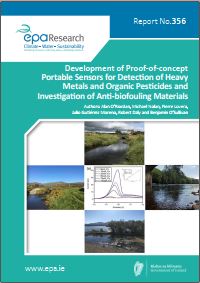Research 356: Development of Proof-of-concept Portable Sensors for Detection of Heavy Metals and Organic Pesticides and Investigation of Anti-biofouling Materials
Authors: Alan O’Riordan, Michael Nolan, Pierre Lovera, Julio Gutiérrez Moreno, Robert Daly and Benjamin O’Sullivan
Summary: One important challenge in the 21st century is the ability to provide a clean and pollutant-free source of water. This project aimed to develop electrochemical and optical-based sensors for detection of organic contaminants (herbicides) and heavy metals. This research has shed light on the potential for the development and optimisation of novel environmental sensors and anti-biofouling strategies.

Water quality :: Environmental Protection Agency, Ireland
https://www.epa.ie/media/epa-2020/publications/research/Thumbnail_356.jpg